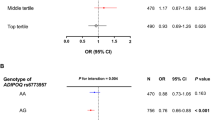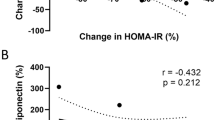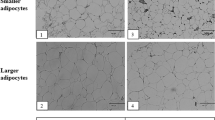Abstract
This study aimed 1) to investigate the relationship between serum adiponectin levels and metabolic disorders and 2) to clarify the usefulness of serum adiponectin level as a diagnostic marker of metabolic syndrome in obese Japanese children. One hundred obese boys aged 8 to 13 years were examined. Serum adiponectin levels were measured by radioimmunoassay using a commercial kit. Abdominal fat thickness (maximum preperitoneal fat thickness: Pmax; minimum subcutaneous fat thickness: Smin) was measured by ultrasonography. The relationships between adiponectin and clinical characteristics were analyzed by simple regression. The relationships between anthropometric measurements and metabolic disorders were analyzed among three groups divided according to adiponectin percentile. The prevalence of metabolic syndrome was also analyzed, with metabolic syndrome defined as the presence of three or more complications of obesity. The criteria for metabolic syndrome by adiponectin were subjected to a receiver operating characteristic (ROC) analysis. Body weight, waist circumference, Pmax, alanine aminotransferase and fasting serum insulin were all inversely correlated with adiponectin. There were significant differences in the prevalence of severe obesity, the accumulation of visceral adipose tissue, hyperinsulinemia, high serum low density lipoprotein-cholesterol, the number of complications of obesity and the prevalence of metabolic syndrome among the three groups. The area under the ROC curve for adiponectin was 0.672±0.055 and the cut-off value was 6.65 μg/ml. Hypoadiponectinemia was associated with visceral fat accumulation and metabolic syndrome in obese Japanese boys. Evaluation of adiponectin might contribute to an early intervention for obese children with metabolic syndrome.
Similar content being viewed by others
Article PDF
References
The Ministry of Education, Culture, Sports, Science and Technology : The Nationwide Statistics of Physical Development for Japanese Children. Tokyo, Printing Development of the Ministry of Finance, 1991 (in Japanese).
The Ministry of Education, Culture, Sports, Science and Technology : The Nationwide Statistics of Physical Development for Japanese Children. Tokyo, Printing Development of the Ministry of Finance, 2001 (in Japanese).
Hiura M, Kikuchi T, Nagasaki K, Uchiyama M : Elevation of serum CRP levels is associated with obesity in boys. Hypertens Res 2003; 26: 541– 546.
Kameda K, Kikuchi T, Yamazaki H, Hiura M, Uchiyama M : The relationship of serum levels of malondialdehyde modified low density lipoprotein to serum lipids and anthropometric measurements in school children. Acta Med Biol 2003; 51: 67– 73.
Kikuchi N, Shiga K, Tokuhiro E : Epidemiology of NIDDM in children. Horumon to Rinsho 1997; 45: 823– 827 (in Japanese).
Klish WJ : Childhood obesity: pathophysiology and treatment. Acta Paediatr Jpn 1995; 37: 1– 6.
Fujioka S, Matsuzawa Y, Tokunaga K, Tarui S : Contribution of intra-abdominal fat accumulation to the impairment of glucose and lipid metabolism in human obesity. Metabolism 1987; 36: 54– 59.
Hirose H, Saito I, Kawabe H, Saruta T : Insulin resistance and hypertension: seven-year follow-up study in middle-aged Japanese men (the KEIO study). Hypertens Res 2003; 26: 795– 800.
Itoh K, Imai K, Masuda T, et al : Relationship between changes in serum leptin levels and blood pressure after weight loss. Hypertens Res 2002; 25: 881– 886.
Maeda K, Okubo K, Shimomura I, Funahashi T, Matsuzawa Y, Matsubara K : cDNA cloning and expression of a novel adipose specific collagen-like factor apM1 (adipose most abundant gene transcript 1). Biochem Biophys Res Commun 1996; 221: 286– 289.
Arita Y, Kihara S, Ouchi N, et al : Paradoxical decrease of an adipose-specific protein, adiponectin, in obesity. Biochem Biophys Res Commun 1999; 257: 79– 83.
Hotta K, Funahashi T, Arita Y, et al : Plasma concentrations of a novel, adipose-specific protein, adiponectin, in type 2 diabetic patients. Arterioscler Thromb Vasc Biol 2000; 20: 1595– 1599.
Ouchi N, Kihara S, Arita Y, et al : Novel modulator for endothelial adhesion molecules: adipocyte-derived plasma protein adiponectin. Circulation 1999; 100: 2473– 2476.
Asayama K, Hayashibe H, Dobashi K, et al : Decrease in serum adiponectin level due to obesity and visceral fat accumulation in children. Obes Res 2003; 11: 1072– 1079.
Stefan N, Bunt JC, Salbe AD, Funahashi T, Matsuzawa Y, Tataranni PA : Plasma adiponectin concentrations in children: relationships with obesity and insulinemia. J Endocrinol Metab 2002; 87: 4652– 4656.
Nemet D, Wang P, Funahashi T, et al : Adipokines, body composition, and fitness in children. Pediatr Res 2003; 53: 148– 152.
Weiss R, Dufour S, Groszmann A, et al : Low adiponectin levels in adlescent obesity: a marker of increased intramyocellular lipid accumulation. J Clin Endocrinol Metab 2003; 88: 2014– 2018.
Iwata F, Okada T, Harada K : Assessment of obesity in children. Int J Obes Relat Metab Disord 2000; 24: 1542.
Yamazaki K, Matsuoka H, Kawanobe S, Hujita S, Murata M : Evaluation of standard body weight by sex, age, and height: on basis of 1990 school year data. J Jpn Pediatr Sci 1994; 98: 96– 102.
Suzuki R, Watanabe S, Hirai Y, et al : Abdominal wall fat index, estimated by ultrasonography, for assessment of the ratio of visceral fat to subcutaneous fat in the abdomen. Am J Med 1993; 95: 309– 314.
Tamura A, Mori T, Hara Y, Komiyama A : Preperitoneal fat thickness in childhood obesity: association with serum insulin concentration. Pediatr Int 2000; 42: 155– 159.
Guidelines Subcommittee of Japanase Society of Hypertension : JSH2000 Hypertension Guidelines for General Practitioners. Japan Scientific Societies Press, Tokyo, 1996 (in Japanese).
Asayama K, Ozeki T, Sugihara S, et al : Criteria for medical intervention in obese children: a new definition of ‘obesity disease’ in Japanese children. Pediatr Int 2003; 45: 642– 646.
Asayama K, Dobashi K, Kodera H, Uchida N, Nakane T, Nakazawa S : Threshold values of visceral fat measures and their anthropometic alternatives for metabolic derangement in Japanese obese boys. Int J Obes Relat Metab Disord 2002; 26: 208– 213.
Nishina M, Kikuchi T, Yamazaki H, Kameda K, Hiura M, Uchiyama M : Relationship among systolic blood pressure, serum insulin and leptin, and visceral fat accumulation in obese children. Hypertens Res 2003; 26: 281– 288.
Kikuchi T, Nagasaki K, Hiura M, Ogawa Y, Tanaka Y, Uchiyama M : Epidemiological strategy for obese children. J Jpn Soc Stu Obes 2004; 10: 12– 17 (in Japanese).
Atzmon G, Yang XM, Muzumdar R, Ma XH, Gabriely I, Barzilai N : Differential gene expression between visceral and subcutaneous fat depots. Horm Metab Res 2002; 34: 622– 628.
Milan G, Granzotto M, Scarda A, et al : Resistin and adiponectin expression in visceral fat of obese rats: effect of weight loss. Obes Res 2002; 10: 1095– 1103.
Weyer C, Funahashi T, Tanaka S, et al : Hypoadiponectinemia in obesity and type 2 diabetes: close association with insulin resistance and hyperinsulinemia. J Clin Endocrinol Metab 2001; 86: 1930– 1935.
Spranger J, Kroke A, Mohlig M, et al : Adiponectin and protection against type 2 diabetes mellitus. Lancet 2003; 18: 226– 228.
Hotta K, Funahashi T, Bodkin NL, et al : Circulating concentrations of the adipocyte protein adiponectin are decreased in parallel with reduced insulin sensivtivity during the progression to type 2 diabetes in rhesus monkeys. Diabetes 2001; 50: 1126– 1133.
Mohlig M, Wegewitz U, Osterhoff M, et al : Insulin decreases human adiponectin plasma levels. Horm Metab Res 2002; 34: 655– 658.
Okamoto Y, Kihara S, Ouchi N, et al : Adiponectin reduces atherosclerosis in apolipoprotein E-deficient mice. Circulation 2002; 26: 2767– 2770.
Yamauchi T, Kamon J, Waki H, et al : Globular adiponectin protected ob/ob mice from diabetes and apoE-deficient mice from atherosclerosis. J Biol Chem 2002; 24: 2461– 2468.
Matsuda M, Shimomura I, Sata M, et al : Role of adiponectin in preventing vascular stenosis: the missing link of adipo-vascular axis. J Biol Chem 2002; 277: 37487– 37491.
Murakami H, Ura N, Furuhashi M, Higashiura K, Miura T, Shimamoto K : Role of adiponectin in insulin-resistant hypertension and atherosclerosis. Hypertens Res 2003; 26: 705– 710.
Yang WS, Lee WJ, Funahashi T, et al : Plasma adiponectin levels in overweigt and obese Asians. Obes Res 2002; 10: 1104– 1110.
Yamamoto Y, Hirose H, Saito I, et al : Correlation of adipocyte-derived protein adiponectin with insulin resistance index and serum high-density lipoprotein-cholesterol, independent of body mass index, in the Japanese population. Clin Sci (Lond) 2002; 103: 137– 142.
Author information
Authors and Affiliations
Corresponding author
Rights and permissions
About this article
Cite this article
Ogawa, Y., Kikuchi, T., Nagasaki, K. et al. Usefulness of Serum Adiponectin Level as a Diagnostic Marker of Metabolic Syndrome in Obese Japanese Children. Hypertens Res 28, 51–57 (2005). https://doi.org/10.1291/hypres.28.51
Received:
Accepted:
Issue date:
DOI: https://doi.org/10.1291/hypres.28.51
Keywords
This article is cited by
-
Cord blood and child plasma adiponectin levels in relation to childhood obesity risk and fat distribution up to 5 y
Pediatric Research (2017)
-
Adiponectin and markers of metabolic syndrome in obese children and adolescents: impact of 8-mo regular physical exercise program
Pediatric Research (2014)
-
Inflammatory markers and metabolic syndrome among adolescents
European Journal of Clinical Nutrition (2012)
-
Adiponectin as a biomarker of the metabolic syndrome in children and adolescents
European Journal of Medical Research (2010)
-
Unfavorable lipoprotein profile in childhood cancer survivors with suprasellar brain tumors—a high Apo B level and increased small dense LDL-cholesterol
Child's Nervous System (2009)



